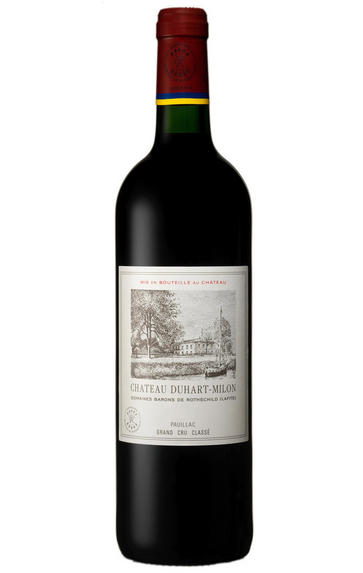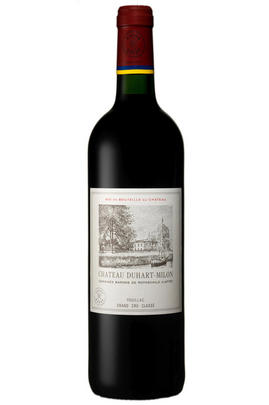
2012 Château Duhart-Milon, Pauillac, Bordeaux

Critics reviews
Robert M. Parker, Jr. - 30/04/2015
Jancis Robinson, jancisrobinson.com, 24 Apr 2013
James Molesworth, Wine Spectator, April 8 2013
Robert Parker - Wine Advocate - Apr 2013
About this WINE

Chateau Duhart-Milon
Château Duhart Milon is a Pauillac estate owned by Domaines Barons de Rothschild that produces on average 28,000 cases of wine per year. The wine chais are located in Pauillac town and the property has a similar climate to that enjoyed by the Médoc: maritime, with the Gironde estuary and the Bay of Biscay combining to act as a climate regulator and the coastal pine forests sheltering the vines from the westerly and north-westerly winds.
Duhart Milon Rothschild's vineyards (Cabernet Sauvignon 65%, Merlot 30%and Cabernet Franc 5%) border Lafite Rothschild. Vinification includes oak ageing, up to 40% new.
Duhart Milon Rothschild is classified as a 4ème Cru Classé.

Pauillac
Pauillac is the aristocrat of the Médoc boasting boasting 75 percent of the region’s First Growths and with Grand Cru Classés representing 84 percent of Pauillac's production.
For a small town, surrounded by so many familiar and regal names, Pauillac imparts a slightly seedy impression. There are no grand hotels or restaurants – with the honourable exception of the establishments owned by Jean-Michel Cazes – rather a small port and yacht harbour, and a dominant petrochemical plant.
Yet outside the town, , there is arguably the greatest concentration of fabulous vineyards throughout all Bordeaux, including three of the five First Growths. Bordering St Estèphe to the north and St Julien to the south, Pauillac has fine, deep gravel soils with important iron and marl deposits, and a subtle, softly-rolling landscape, cut by a series of small streams running into the Gironde. The vineyards are located on two gravel-rich plateaux, one to the northwest of the town of Pauillac and the other to the south, with the vines reaching a greater depth than anywhere else in the Médoc.
Pauillac's first growths each have their own unique characteristics; Lafite Rothschild, tucked in the northern part of Pauillac on the St Estèphe border, produces Pauillac's most aromatically complex and subtly-flavoured wine. Mouton Rothschild's vineyards lie on a well-drained gravel ridge and - with its high percentage of Cabernet Sauvignon - can produce (in its best years) Pauillac's most decadently rich, fleshy and exotic wine.
Latour, arguably Bordeaux's most consistent First Growth, is located in southern Pauillac next to St Julien. Its soil is gravel-rich with superb drainage, and Latour's vines penetrate as far as five metres into the soil. It produces perhaps the most long-lived wines of the Médoc.
Recommended Châteaux
Ch. Lafite-Rothschild, Ch. Latour, Ch. Mouton-Rothschild, Ch. Pichon-Longueville Baron, Ch. Pichon Longueville Comtesse de Lalande, Ch. Lynch-Bages, Ch. Grand-Puy-Lacoste, Ch, Pontet-Canet, Les Forts de Latour, Ch. Haut-Batailley, Ch. Batailley, Ch. Haut-Bages Libéral.

Cabernet Sauvignon Blend
Cabernet Sauvignon lends itself particularly well in blends with Merlot. This is actually the archetypal Bordeaux blend, though in different proportions in the sub-regions and sometimes topped up with Cabernet Franc, Malbec, and Petit Verdot.
In the Médoc and Graves the percentage of Cabernet Sauvignon in the blend can range from 95% (Mouton-Rothschild) to as low as 40%. It is particularly suited to the dry, warm, free- draining, gravel-rich soils and is responsible for the redolent cassis characteristics as well as the depth of colour, tannic structure and pronounced acidity of Médoc wines. However 100% Cabernet Sauvignon wines can be slightly hollow-tasting in the middle palate and Merlot with its generous, fleshy fruit flavours acts as a perfect foil by filling in this cavity.
In St-Emilion and Pomerol, the blends are Merlot dominated as Cabernet Sauvignon can struggle to ripen there - when it is included, it adds structure and body to the wine. Sassicaia is the most famous Bordeaux blend in Italy and has spawned many imitations, whereby the blend is now firmly established in the New World and particularly in California and Australia.


Buying options
Add to wishlist
Description
This wine really plays to the strengths of the vintage with 53% Merlot in the blend, and it shines through on the nose especially, with ripe plummy fruit present on the bouquet. It is soft and easy on the palate, with an edge of minerality adding a twist of freshness to the rich berry fruit. The finish is crisp, with the softest, ripest of tannins making this an incredibly drinkable wine.
Chris Pollington, Private Account Manager
Duhart Milon reveals a pleasing purity and sense of elegance with ripe, even plump, fruit all progressing neatly in a laid back, easy manner which is a credit to the team at Ch. Lafite who have resisted stretching the wine. It hasn’t great weight, and nor should it in a vintage like ‘12, but with its satisfying, sweet fruit it will make fine early drinking.
Tom Cave, Cellar Plan Manager
wine at a glance
Delivery and quality guarantee